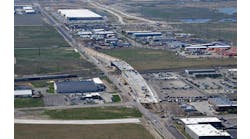By Clint Goodin, Contributing Author
Last July, thunderstorms rolled over eastern Kentucky, bringing heavy rain and flash flooding to the area. The flooding covered six counties from Breathitt to Pike, causing 45 fatalities, damaging or destroying over 10,000 homes, and leaving numerous roads and bridges damaged.
Multiple local and state agencies responded to the flooding with the Kentucky Transportation Cabinet (KYTC) being among the first. They began clearing roadways and assessing damage.
KYTC’s responsibilities expanded to debris removal, management, and establishing temporary housing for those whose homes had been impacted.
Bridge inspections began immediately after the water receded. Information from these bridge inspections was processed by KYTC’s bridge office and prioritized based on the level of damage to the structure, availability of alternate means of access, and importance of the highway itself. Thirty-three of these bridges were given the highest priority as emergency replacements.
The priority bridge replacements were structures that were damaged beyond use or washed out and had extenuating circumstances. Many of these bridges are the only way to provide vehicular access to communities throughout this part of the state. A few of the bridges in need of immediate repair had other means of access, but required a long detour or were important to maintain through traffic.
KYTC had two main directives for these bridges. First, restore temporary access as soon as possible and second, concurrently develop roadway and structure plans for the replacement. These directives guided the design and construction process throughout the duration of the project.
The Emergency Bridge Team achieved these directives by leveraging the foundation of the state’s Bridge Management Program, focusing on innovation in speed of delivery, and maintaining focused coordination through the response.
Bridge Management Program
The Emergency Bridge Team had its origins in the Bridging Kentucky program. Beginning in 2018, the program had the goal of replacing 1,000 deficient bridges in six years. In 2021, the team working on this program was reconfigured into the Kentucky Bridges GEC. The team was comprised of Stantec, AECOM, Strand, and Qk4.
Emergency bridges were assigned to a Design Team Lead (DTL) by KYTC in batches between August 4 and August 31. The DTL would meet with KYTC and the contractor on site to develop an action plan. The DTL would document the plan of action and distribute it to the design discipline leads, KYTC, and the contractor to get buy-in before the design proceeded too far. While this procedure was going on, surveyors and geotechnical engineers were in the field gathering information to complete the design.
While designing the structure, the contractor would submit a separate price to KYTC for clearing the flood debris, demolition of the existing bridge if necessary, and restoring access. Most access was temporarily restored using low water crossings. The contractor would install enough pipe to maintain a hydraulic opening determined by the design team and cover it with clean crushed stone. A few routes had detours available, and debris removal and demolition occured while bridge plans were under design.
Effective Project Delivery
The emergency bridges had multiple design considerations. Following KYTC’s directives, delivery speed was crucial. Federal Emergency Management Agency (FEMA) guidelines had to be considered because most of the funding for these bridges came from this agency.
The first decision was structure type. While all the original structures were bridges, some of them were small enough to be effectively replaced with a concrete box culvert. Next was beam type. KYTC had available steel beams left over from the Brent Spence bridge repair project. If the available steel beams did not work, prestressed concrete box beams were used. Beam orders were placed directly by KYTC using the design team’s beam design.
Another issue to determine was foundation type. The foundations used were spread footer on rock, H-piles driven to refusal, and H-piles drilled into rock. For hydraulic design, the hydraulic opening was kept as close to the existing opening size as practical.
Other considerations arose on a site-by-site basis. Since time was not available to wait on utility relocation, design changes were made to avoid or mitigate the conflict. Some bridges had overhead electrical lines that crossed an abutment. Where piling had to be used, the contractor coordinated with the power company to de-energize the lines while piling was being placed.
In other locations, waterlines had to be temporarily supported while the work went on around them. Some sites had property issues that needed to be resolved through negotiation. The team also received input from the public on some bridges that was helpful during the design.
On one bridge, locals complained that they could not see the bridge deck when approaching from the west due to a steep grade and some vehicles had run off the edge of the bridge. A guardrail barrier was added to this bridge to improve its visibility to oncoming traffic.
Coordination Was Key
Coordination was crucial to constructing the bridges. The design team had daily meetings with the KYTC program manager, and issues that could cause a delay were discussed and solutions developed.
Weekly meetings were held with KYTC district personnel to update them on the progress of the design and receive input on their concerns. All project data was posted to a Teams site to which all the design team and KYTC staff had access.
The progress and decisions on each project were journaled by the DTL’s daily on this site. Coordination also included meetings with third parties such as property owners, utilities, and railroad. Considering the emergency nature of the work and the scale of destruction, nearly all were cooperative in moving the projects forward.
Bridge construction packages were delivered in batches. This facilitated the construction procurement process and kept DTL’s from competing with one another for limited resources.
Each construction package developed by one firm received an independent review by another firm on the team. Then, the construction package was sent out for review. A meeting was held the next day to work out any issues had by the contractor and KYTC. Final revisions were made, and final plans were delivered to KYTC and the contractor.
The first construction packages were delivered to the contractors on August 24 and the final ones on September 30.
The accelerated nature of the plan development required some issues to be addressed during construction. The DTL’s remained available for coordination of design questions and shop drawing review. The design team provided construction liaisons that were available to conduct site visits and recommend solutions to any problems that were encountered. Any field decisions made were included in the project journal by the DTL.
Three Months Later
The first bridges began to be opened to traffic as early as October, three months after the floods hit. Even though the emergency bridge program included only a fraction of the total number of bridges that needed to be repaired or replaced, it was an effective way to quickly deliver the critical structures.
It would be hard to overstate the destruction that occurred in eastern Kentucky due to this flooding. This program has delivered resilient structures that will endure the next flood and provide decades of dependable access for the citizens of eastern Kentucky. R&B
Clint Goodin is a senior project manager in Stantec’s Lexington, Ky. office.



